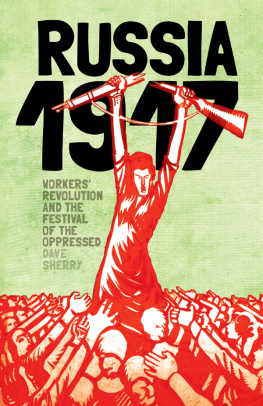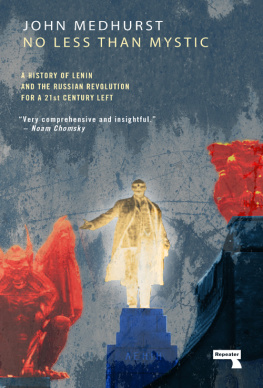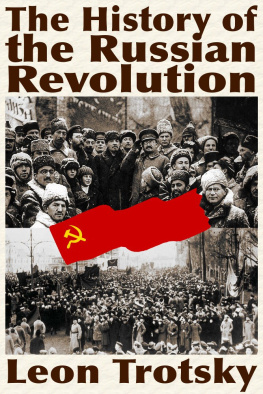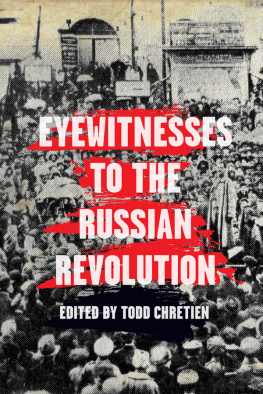Praise for The Womens Revolution
Many have heard that the February Revolution began on International Womens Day. But rarely if ever has the story been told of womens lengthy, persistent and pivotal contribution to the fuller history of the Russian Revolution and of the Bolshevik Party in particular. Nor has the centrality of working-class feminism to that contribution been so thoroughly examined. In a richly detailed, absorbing account, Judy Cox reveals just that, making one wonder how the courage, brilliance and sheer number of women who helped change the course of history could ever have been missed in the first place!
SUE FERGUSON, associate professor, Wilfrid Laurier University
This is a story of women fighting at barricades, of women theorising capitalism, of women robbing trains, and women smuggling weapons to fight the Tsar. Judy Cox has recovered for us not a narrative of achievements by exceptional women, but rather the more important history of how ordinary women, with revolutionary intentionality, fought, and nearly won, against capital. They are the true foremothers of feminism for the 99%.
TITHI BHATTACHARYA, Feminism for the 99%
In The Womens Revolution, 1905-1917, Judy Cox places women at the centre of revolutionary organising, agitation and leadership in Russia. Her lively narrative ties Russian womens activism to that of other women in the European revolutionary tradition. Coxs vivid accounts of womens contributions at all levels of the Bolshevik Party organisation turn the table on those histories that marginalise women revolutionaries.
BARBARA C. ALLEN, Leaflets of the Russian
Revolution: Socialist Organizing in 1917
The Womens Revolution is an important reminder of the key role women played in the Russian Revolution of 1917. From Nadezhda Krupskaya to Alexandra Kollontai, women not only strategised about how to overturn the Tsarist regime and build a communist society, but also theorised and attempted to put into practice how such a new society could rid itself of entrenched misogyny.
SARA R. FARRIS, In the Name of Womens
Rights: The Rise of Femonationalism
The Womens RevolutionThe Womens Revolution:
Russia 19051917
Judy Cox
2017 Judy Cox
First published in Great Britain in 2017 by Counterfire.
This edition published in 2019 by
Haymarket Books
P.O. Box 180165
Chicago, IL 60618
773-583-7884
www.haymarketbooks.org
ISBN: 978-1-60846-786-0
Distributed to the trade in the US through Consortium Book
Sales and Distribution (www.cbsd.com) and internationally
through Ingram Publisher Services International
(www.ingramcontent.com).
This book was published with the generous support of
Lannan Foundation and Wallace Action Fund.
Special discounts are available for bulk purchases by
organizations and institutions. Please call 773-583-7884 or
email for more information.
Cover design by Jamie Kerry.
Library of Congress Cataloging-in-Publication data is
available.
Introduction: The train
When Lenin arrived at the Finland Station in April 1917 he had already decided that the February Revolution could not be the end of the Russian Revolution. He was committed to fighting for a second, socialist revolution. That much, many socialists know. If pressed, we might recall that he was not alone on the famous sealed train, that his closest collaborator Grigory Zinoviev was with him. Karl Radek might also come into the picture after all, he later wrote an account of the journey and of course, there was the ever-loyal Nadezhda Krupskaya, Lenins wife, and Inessa Armand, another of Lenins closest collaborators. It might seem more surprising that Krupskaya and Armand were not the only female passengers.
Zlata Lilina Zinovieva was also on board. She had joined the Russian Social Democratic and Labour Party (RSDLP) in 1902, becoming a member of the Bolshevik faction the following year. She was active in the 1905 Revolution in St Petersburg and joined Lenin in exile with her husband Grigory Zinoviev. Together they became two of Lenins closest allies during some eight years of exile. Zlata Lilina went on to be a key party activist in 1917. Another female passenger was Olga Ravich. She had joined the RSDLP in 1903 and four years later she was arrested after taking part in a Bolshevik-organised bank raid in Tiflis. She had also been married to Zinoviev, but by 1917 they were divorced. She too continued to be a respected and active party member and became a well-regarded writer after the revolution.
Lenin was at the heart of the Bolshevik Party. He was central to steering the party away from compromise and betrayal in April 1917 and to seizing power in October. But he was not alone. The women who shared his exile did not confine themselves to mending stockings and making the tea. They were Marxist revolutionaries who were committed to the emancipation of the working class. They all went on to play important roles in the revolutionary regime, becoming delegates to congresses and members of key committees. Yet today, it is hard to find any references to Zlata Lilina or to Olga at all, never mind to discover what they thought, what they argued or how they contributed to Lenins perspective in the course of the revolution. Krupskaya and Armand are more prominent but tend to be seen purely as Lenins helpers, transmitting his words to the wider world.
Lenin was certainly a towering figure of 1917 but at every stage of the revolution there were women debating, theorising and organising alongside him. While he is still either reviled or worshipped as the architect of the socialist revolution, the women close to him have been relegated to the shadows.
Section One
Revolutionary Times
1. Where are the women?
Women have been written out of all aspects of the Russian Revolution by historians of left and right, of East and of West. The dominant narrative of the revolution in the West portrays the Bolshevik Party as an organisation of iron-willed male fanatics who seized power behind the backs of the working class. Women had no role to play in this macho coup. In Stalinist histories, there was only room for the two great men who created the Soviet Union: Lenin and Stalin. Women were airbrushed out of leading roles, just as was Leon Trotsky.
Historians more sympathetic to the Bolsheviks have been little better. Elena Stasova was a Bolshevik leader willing and able to take orders, energetic, fearless and devoted to revolutionary politics. She was a staunch ally of Lenin and his wife Krupskaya in the underground movement, and she later served on key party committees. She served as the secretary to the Bolshevik Party Central Committee throughout 1917. Stasova was such a powerful figure that she was nicknamed Absolute, yet in Alexander Rabinowitchs well-regarded 400-page book, The Bolsheviks Come to Power, she is literally reduced to a footnote.
Historians taking a more social approach have tended to relegate women to the unskilled and less organised sections of the workforce, and leave them there. These women workers may have set the revolution in motion with their riots for bread and herrings, but they quickly retreated back into the shadows to let the men take over the serious business of taking power. Richard Stites argues in











